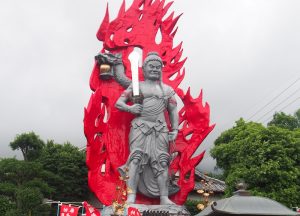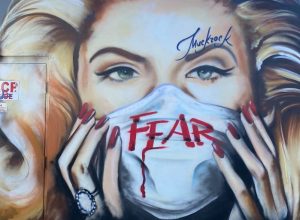
I am honored to join the team of BDG writers and look forward to connecting with you each month.
Through this column, my intention is to reflect on how the Dharma gives us a path to understand and respond to collective challenges, such as the climate emergency, social breakdown, and racial and economic injustice. We are living through falling-apart times and this can be terrifying and painful when we don’t have a spiritual or moral compass to guide us. But when we are able to reference deep and abiding spiritual truths in a way that is authentic to our lives, we open up the possibility of finding a way to break through suffering.
My first step on the path of walking the Buddha’s way was taking a course on “Buddhism, Shamanism, and Deep Ecology” with Roshi Joan Halifax at the California Institute of Integral Studies in 1993. What a great title for a class, right?! It rolled together all my passionate points of inquiry at the time. While I’d long been interested in Buddhism, before moving to the San Francisco Bay Area for graduate school that year I lived in places where it wasn’t easy to find opportunities to meditate. When I arrived in the Bay Area that fall, I reveled in the abundance of sanghas and centers.
A portion of Roshi Joan’s class was structured as a mindfulness retreat in the tradition of Thich Nhat Hanh, who was her teacher in those days. While it took some adjusting to be in all that silence and slowing-down-ness, I soaked up the practice and knew I’d found my spiritual home. Afterward, I connected with Therese Fitzgerald and Arnie Kotler, both teachers in the Order of Interbeing, and started a consistent practice under their mentorship and with the sangha they founded in the East Bay. That’s where it all began . . .
My way seeking heart/mind has gone through many iterations since then, and I am grateful to those who have supported my path, including Roshi Joan, Therese and Arnie, and most especially Shosan Victoria Austin, who has been my teacher for more than 20 years.
By way of introduction in this first column, I thought I’d share three phrases that have guided my life since I first began to practice within the Buddhist tradition.
Just this
When Dongshan, a Chan Buddhist monk of the Tang dynasty, was ready to leave his teacher, Yunyan, he asked: “If someone asks me if I can depict your reality, or your teaching, how shall I reply?” Yunyan paused and then answered, “Just this is it.”
The shortened version, “just this,” serves as my lifeline back to the home in my heart when I’m feeling swamped by despair, overwhelm, or distraction.
Many years ago, a friend who was a longtime Zen practitioner shared those words with me during a time of turmoil in my life. That phrase went straight to my heart. It bypassed all the crazy thoughts and intense emotions I was swimming in, and re-focused my attention on what was right in front of me. To this day it continues to serve the same purpose.
“Just this” invites me into the question: what needs tending to in this very moment?
• It might be my heart, simply making time to feel whatever is going on inside of me, with unconditional love.
• It might be my physical well-being, being reminded that I need to put some wholesome food in my system, or move my body and take a long walk, or get some sleep.
• It might be finally doing a difficult task that I’ve been avoiding, such as making a phone call to deal with a challenging situation.
• It might be a collective step we need to take together as a community, such as installing a stop sign at a dangerous intersection, or creating space for a brave conversation about race and class that’s been avoided for too long.
In the intensity of overwhelm, I can feel paralyzed or scattered. But if it’s just that one thing, I know I can do it. That’s the gift of “just this.” And it’s as close as my next breath.
The appropriate response
This one comes from another short Zen story. A monk asked Yun Men: “What are the teachings of a whole lifetime?” Yun Men replied: “An appropriate response.”
I would hear that story a lot when I first studied and practiced Zen and it didn’t really sink in. Until it did. Illuminating the lightbulb over my head was a slow process that came more through witnessing the way senior Zen students and teachers responded to situations than it did through any deep concentration on those words. I noticed that they were incredibly skilled at staying open to the ever-changing truths of a complex situation and intuitively finding a skillful response. This was so different to the black-and-white “good or evil” paradigm I grew up with in the Catholic church. Instead, it’s rooted in the principle of upaya, a Pali word that is often translated as “skillful means.”
What I began to understand is that while the Dharma gives us an ethical framework from which to act—the precepts—every situation is unique, and there is very rarely a one-size-fits-all response. We have so many possibilities and tools at our disposal, so many skillful means depending on what’s needed. What’s most important is to stay present, to inquire deeply, and to embrace being with not knowing, the first tenet of the Zen Peacemaker Order.
Treat nothing like an object
This phrase came to me from Vicki Austin and Hozan Alan Senauke, passed down by their teacher, Sojun Mel Weitsman, abbot of Berkeley Zen Center. This is another phrase that comes most clearly to life through everyday practices rather than intellectual contemplations.
Back in the days when I spent a lot of time in a zendo, along with everyone else I moved through the flow of entering the hall with a bow, stepping in a certain way to get to my zafu (cushion), sitting through the periods of zazen, and then at the end fluffing my zafu so that it would be ready for the next person. Everything was regimented but in a manner I found quite beautiful.
Occasionally, I was assigned to the team that cleaned the zendo. We would pick up the zafus and zabutons and then thoroughly sweep and mop the floor, brush off the cushions, and replace everything, just so. “Treat nothing like an object” was ingrained in my body and mind as we did these tasks. I realized that the cushions were as much a part of our practice as any sutra, and the phrase reminded me to treat them with gratitude and respect. Once in a while, someone new to the practice would throw a zafu across the room onto the floor and I felt as if my best friend had just been insulted.
This practice can of course extend to everything, not only to the items in the meditation hall, and not even to items but to people as well. It can be rather frightening to watch ourselves and notice how often we slip into treating people like objects. Think of your interaction with the person behind the cash register at the grocery store. As I go through my day, I notice how different it feels to engage with every person or item as if they are an old friend. This is the root of care, and this kind of love is the medicine we so desperately need these days.
I’ve stayed fairly personal in my sharing on these three phrases, but each can also inform our collective views and actions. When we feel despair and overwhelm from being immersed in the reality of the climate crisis, how can “just this” return us to basic sanity and help us to understand the next step? What is the “appropriate response” when we’re faced with a situation that is infused with racism? How does it shift our relationship to a person or a thing when we remember to “treat nothing like an object”?
I really enjoy dialogue with readers, so I invite you to share your own reflections in the comments here, either about the phrases I’ve shared or about Dharma phrases that give you a compass by which to navigate. Thanks for allowing me into your world!
Related features from BDG
In a Moment, in a Breath: 55 Zen Meditations from Roshi Joan Halifax
Sakyadhita Spain Symposium 2020: Roshi Joan Halifax
Compassion at the Edge
Modern Koans
The Detached View of One Who Knows
Buddhist Voices in the Climate Crisis: Earth Words and Watershed Activism
Living in the Saha World













Insightful and illuminating. Thanks, Maia. How about “One Step?”
thank you, Yael! “One Step” is definitely another guidepost… similar to Just This.
This is wonderful Maria, how do I ensure I receive all your posts??
Hi Cindy, You can subscribe to Buddhist Door Global, and they will send out emails to highlight various writers, including me. Thank you for your interest!
My seniors in my zendo like to say, “When you see the Buddha, kill the Buddha.”
And: “before enlightenment, chop wood, and carry water. After enlightenment, chop wood, and carry water.”
Indeed!